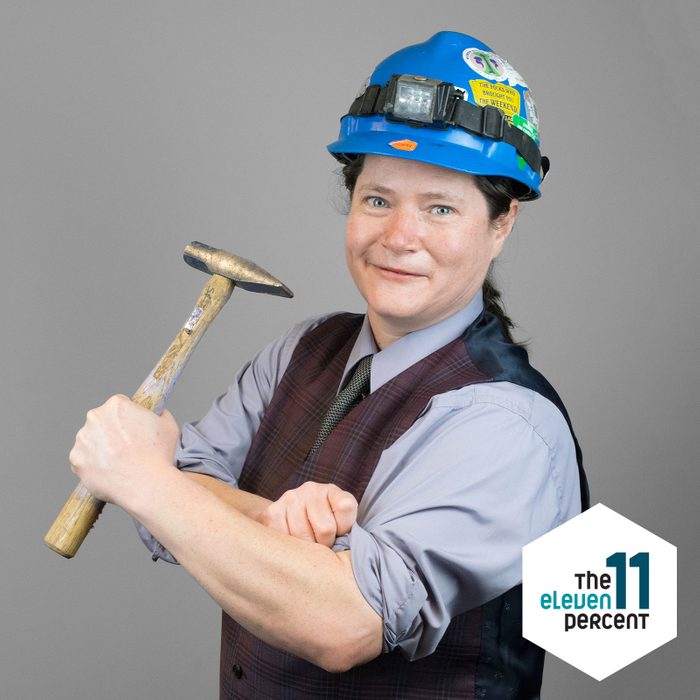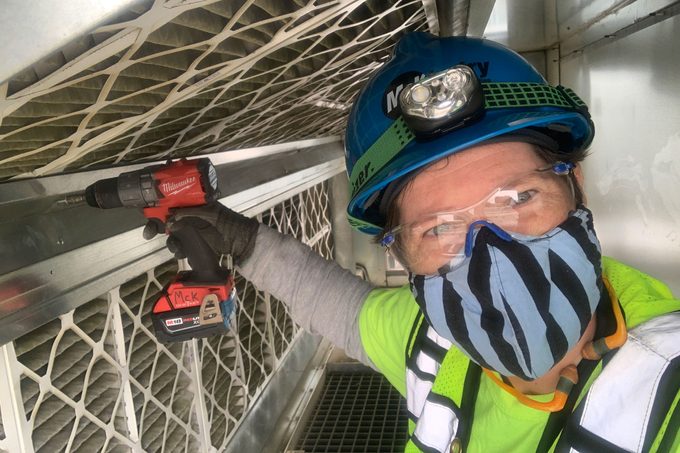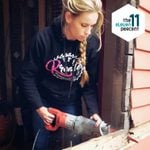The Eleven Percent: Soph Davenberry, Sheet Metal Worker

Davenberry talks about building for a just future and the need for creative collaboration among trades.
Our editors and experts handpick every product we feature. We may earn a commission from your purchases.
This FH series spotlights the women and nonbinary tradespeople who make up 11 percent of the construction workforce in America. Know someone we should feature? Email us here.
Soph Davenberry left college with a liberal arts degree but without an instantly employable set of skills. While barely scraping by, Davenberry saw a newspaper ad for an apprenticeship in sheet metal. Davenberry, who uses the pronoun they, had no idea what it entailed, but decided to apply.
It proved a life-changing decision. Now, 26 years later, they’re an industry expert in sheet metal and HVAC. They went back to school a few years ago, working full time while earning their second degree, this time in applied science with a focus on sustainable building and science technology.
“And I paid for them both with my job in the trades,” they say.
We ask Davenberry for their thoughts on the state of the sheet metal and HVAC industries, and the increasing amount of creativity their role requires.
Q: Did you have background in the trades before your apprenticeship?
A: Not really. My mom was a social worker and my dad was a college professor. I was interested in shop class in middle school, but the instructor would make the girls hand their piece of wood to him so he could run it through the table saw and then hand it back to us. I realized I was not going to be learning a lot from him, so I switched to home economics.
I did get a little bit of construction work experience while volunteering with Habitat for Humanity a few times as a teenager.
Q: What are some of your more memorable projects?
A: I’ve worked on a lot of interesting projects over the years, from the rooftops of skyscrapers to a hospital wing addition that lasted off and on for eight years.
One I’m particularly proud of was a large underground transit tunnel with two tracks. We had to measure the airflow in that tunnel when the fire life safety systems were on, which were huge fans that moved hundreds of thousands of cubic feet of air.
We had to figure out the volume, which wasn’t a straightforward formula because it wasn’t exactly a circle, there were platforms for where people would be standing, and the company I worked for wasn’t on AutoCAD (a computer-aided design and drafting software application). And so I calculated it by hand, from the drawings.
Toward the end, when the engineers were double-checking the values I had for the air flows, they finally had a computer program to figure it out. For something that was 80 feet or more in diameter, I was within a couple of square feet. So that was pretty good, and a lot of fun.
Q: What changes have you seen in your trade over the last 10 years?
A: The pandemic brought more public awareness to the importance of indoor air quality, so what I do for a living became more visible to people in general.
Then there have been technology changes with architectural sheet metal. We’re now using electric suction grips to build rainscreen assemblies, detailers are working in virtual 4D models, and as a balancer, I’m using wireless tools and cloud software to make my adjustments and report them more efficiently.
In terms of diversity, I’m also working with women and nonbinary folks more often. Find out about Jessie Cannizzaro, a plumbing contractor.
Q: What sort of changes do you see coming down the industry pipeline?
A: Much of our energy is used by buildings, and I think we can make a significant difference with their efficiency, to shift to a more sustainable use of our planetary resources.
Already, energy codes are changing. Instead of prescribing what materials we use in different buildings, they’re now asking just for the end result of how well a building actually performs. It’s that pivot from telling us how to build stuff to letting us come up with ways to reach the desirable end goal that I’m really interested in. It leaves it more wide open for people to really get creative. Meet Renee Wilson, an insulation contractor and owner.
Q: Where do you then find inspiration for creative building solutions?
A: Last June I was at an international tradeswomen’s conference in London, where the general public is a lot more aware of building systems, how buildings function and the dire need to be able to curb our use of carbon-producing fuels.
One of the innovations I saw there was using the piles driven down to support buildings as heat pumps, which combines what seems like two very different things into the same function. Who would have ever thought that I, as an HVAC technician, would have stuff in common with the pile driver? But we do, and that’s the mix-up we’re starting to see more of.
I’m really excited for us in the trades to work more collaboratively. I think sometimes we get hung up in jurisdiction, but we have a lot to share.
Q: How do you think people in the industry can facilitate these environmental changes more effectively?
A: I see a couple places that are a little fractured. One is that many of the folks pushing for energy codes have a more academic background, coming through college or university, and not as many have worked with the tools.
There can also be assumptions about what those of us putting stuff together out in the field are capable of doing and have a passion about. So having more dialogue with the crews who are doing the actual installation work about their ideas of how to do things better would help. And some folks are realizing this.
Then on the flip side, those of us who are out in the field need to recognize that it’s not just a bunch of bureaucratic rules, but that how we behave and work affects the places we love to be in.
There are so many folks in the trades who enjoy being outside and being in forests, and by lakes and rivers. If we want to keep those things around and healthy, we need to change some of our practices.
Q: Do you find anything challenging or beneficial about being nonbinary in your field?
A: Yes, both!
What’s most challenging for me is people onsite making assumptions about my experience based on my appearance, as especially in safety gear, I can be read as young, even though I’ve been in the trade for 26 years. I’ve participated in many tradeswomen events, and I do my best to represent as someone who has a lot of experience as a woman in the trades.
On the other hand, my genderqueer identity is far more expansive. So while I thrive on my pride as a tradeswoman, even then I am not celebrating my full self.
I think what’s beneficial about being nonbinary is being able to bring forward the aspects of my gender that are helpful in each circumstance, such as when I’m the only non-guy on a crew or when a tradeswoman has been my mentor.
Q: What are your pro-specific tools?
A: There are definitely tools that I load into my work pants every day, like a nine-in-one screwdriver set, my Leatherman (multi-tool) and a flashlight.
As for trade-specific tools, I use an airflow hood, which gets fitted onto an air diffuser, to measure velocity. Then a little handheld meter does the calculations to tell me what their airflow is. That meter can be connected to many options, like a flow hood, velgrid, airfoil or pilot tube.
I also use a magnet and extending paint pole for setting off smoke detectors for Fire Life Safety damper inspections. I can also use the extending paint pole with a Bluetooth flow hood to float the hood up 20 or 30 feet in the air and then have the meter down with me. (Then) I don’t have to get a ladder or lift, or have another worker there to tell me the readout to make adjustments.
Then there’s cloud software like Building Start, Blue Rithm, CX Alloy and TABopts, which ties everything together by recording and reporting all of the data, or product, of my work.
Soph Davenberry Bio
Soph Davenberry have been an active union sheet metal worker for more than 26 years. They’ve worked throughout Turtle Island (North America) and abroad, in shop and field for many aspects of the trade including Architectural, Industrial, Commercial HVAC, Test, Adjust and Balance (TAB), organizing, instruction, business development and certification. They’re now in the field as a TAB tech at McKinstry.
Davenberry have a passion for building systems and social justice, leveraging their dual journey cards, formal education and public speaking talents to advocate for better building systems and human organizations.
Writer Karuna Eberl Bio
Karuna Eberl is a regular contributor to FamilyHandyman.com. She spent the last 25 years as a freelance journalist and filmmaker, telling stories of people, nature, travel, science and history. Eberl has won numerous awards for her writing, her Florida Keys Travel Guide and her documentary The Guerrero Project.




